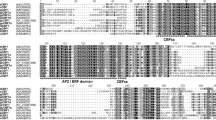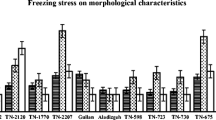Abstract
In comparison to herbaceous plants, studies of cold responsive genes and cold signaling in woody perennials are limited. Since most woody plants have evolved freezing tolerance (FT) in winter, together with similar lignified structures and winter adaptive mechanisms, it is more likely to find cold resistant genes in woody plants growing in temperate and arctic regions. In this study, Ammopiptanthus mongolicus, an evergreen, broadleaf and leguminous shrub was selected as a model to study cold tolerance in woody plants. Thirteen cold up-regulated cDNAs (including eight full-length cDNAs and five partial cDNAs) were cloned from A. mongolicus. One of these genes, AmEBP1, confers enhanced cold tolerance to E. coli and obvious increased freezing survival to Arabidopsis. In transgenic Arabidopsis expressing AmEBP1, transcript levels of some downstream genes in cold signaling exhibit increased accumulation upon cold treatment. Together with structural information, sub-cellular location, and promoter analysis data, it is suggested that AmEBP1 enhances plants cold tolerance by accelerating ribosome biogenesis and the concomitant translation of cold induced transcription factors and downstream protective proteins under cold stress.






Similar content being viewed by others
Abbreviations
- AFPs:
-
Antifreeze proteins
- CA:
-
Cold acclimation
- cDNA-AFLP:
-
cDNA-amplified fragments length polymorphism
- eIF2α:
-
α-Subunit of the eukaryotic initiation factor
- FT:
-
Freezing tolerance
- GUS:
-
β-Glucuronidase
- HsEBP1:
-
An ErbB3 binding protein from Human
- ICE1:
-
Inducer of CBF expression 1
- IPTG:
-
Isopropyl-β-D-thiogalactopyranoside
- LT:
-
Low temperature
- NLS:
-
Nuclear localization signal
- PKR:
-
dsRNA-activated protein kinase
- pPKR:
-
Plant dsRNA-activated protein kinase
- RACE:
-
Rapid amplification of cDNA ends
- RNP:
-
Ribonucleoprotein
- SD:
-
Short daylength
- TAIL-PCR:
-
Thermal asymmetric interlaced PCR
- TDF:
-
Transcript-derived fragment
References
Abe H, Urao T, Ito T, Seki M, Shinozaki K, Yamaguchi-Shinozaki K (2003) Arabidopsis AtMYC2 (bHLH) and AtMYB2 (MYB) function as transcriptional activators in abscisic acid signaling. Plant Cell 15:63–78. doi:10.1105/tpc.006130
Bachmann M, Keller F (1995) Metabolism of the raffinose family oligosaccharides in leaves of Ajuga reptans L. (inter- and intracellular compartmentation). Plant Physiol 109:991–998
Baranowskij N, Frohberg C, Prat S, Willmitzer L (1994) A novel DNA binding protein with homology to Myb oncoproteins containing only one repeat can function as a transcriptional activator. EMBO J 13:5383–5392
Bayliss FT, Ingrahm JL (1974) Mutation in Saccharomyces cerevisiae conferring streptomycin and cold sensitivity by affecting ribosome formation and function. J Bacteriol 118:319–328
Chinnusamy V, Ohta M, Kanrar S, Lee BH, Hong X, Agarwal M, Zhu JK (2003) ICE1: a regulator of cold-induced transcriptome and freezing tolerance in Arabidopsis. Genes Dev 17:1043–1054. doi:10.1101/gad.1077503
Chomczynski P, Sacchi N (1987) Single-step method of RNA isolation by acid guanidinium thiocyanate-phenol-chloroform extraction. Anal Biochem 162:156–159. doi:10.1016/0003-2697(87)90021-2
Danyluk J, Perron A, Houde M, Limin A, Fowler B, Benhamou N, Sarhan F (1998) Accumulation of an acidic dehydrin in the vicinity of the plasma membrane during cold acclimation of wheat. Plant Cell 10:623–638
Datta B (2000) MAPs and POEP of the roads from prokaryotic to eukaryotic kingdoms. Biochimie 82:95–107. doi:10.1016/S0300-9084(00)00383-7
Fei YB, Cao PX, Gao SQ, Wang B, Wei LB, Zhao J, Chen G, Wang BH (2008) Purification and structure analysis of antifreeze proteins from Ammopiptanthus mongolicus. Prep Biochem Biotechnol 38(2):179–190. doi:10.1080/10826060701885126
Fowler S, Thomashow MF (2002) Arabidopsis transcriptome profiling indicates that multiple regulatory pathways are activated during cold acclimation in addition to the CBF cold response pathway. Plant Cell 14:1675–1690. doi:10.1105/tpc.003483
Gilmour SJ, Zarka DG, Stockinger EJ, Salazar MP, Houghton JM, Thomashow MF (1998) Low temperature regulation of the Arabidopsis CBF family of AP2 transcriptional activators as an early step in cold-induced COR gene expression. Plant J 16:433–442. doi:10.1046/j.1365-313x.1998.00310.x
Horvath BM, Magyar Z, Zhang Y, Hamburger AW, Bako L, Visser RG, Bachem CW, Bogre L (2006) EBP1 regulates organ size through cell growth and proliferation in plants. EMBO J 25:4909–4920. doi:10.1038/sj.emboj.7601362
Hutchison HT, Hartwell LH, McLaughlin CS (1969) Temperature-sensitive yeast mutant defective in ribonucleic acid production. J Bacteriol 99:807–814
Jaglo KR, Kleff S, Amundsen KL, Zhang X, Haake V, Zhang JZ, Deits T, Thomashow MF (2001) Components of the Arabidopsis C-repeat/dehydration-responsive element binding factor cold-response pathway are conserved in Brassica napus and other plant species. Plant Physiol 127:910–917. doi:10.1104/pp.127.3.910
Jones PG, Mitta M, Kim Y, Jiang W, Inouye M (1996) Cold shock induces a major ribosomal-associated protein that unwinds double-stranded RNA in Escherichia coli. Proc Natl Acad Sci USA 93:76–80. doi:10.1073/pnas.93.1.76
Kedersha N, Anderson P (2002) Stress granules: sites of mRNA triage that regulate mRNA stability and translatability. Biochem Soc Trans 30:963–969. doi:10.1042/BST0300963
Kim KY, Park SW, Chung YS, Chung CH, Kim JI, Lee JH (2004) Molecular cloning of low-temperature-inducible ribosomal proteins from soybean. J Exp Bot 55:1153–1155. doi:10.1093/jxb/erh125
Langland JO, Langland LA, Browning KS, Roth DA (1996) Phosphorylation of plant eukaryotic initiation factor-2 by the plant-encoded double-stranded RNA-dependent protein kinase, pPKR, and inhibition of protein synthesis in vitro. J Biol Chem 271:4539–4544. doi:10.1074/jbc.271.8.4539
Liu YG, Mitsukawa N, Oosumi T, Whittier RF (1995) Efficient isolation and mapping of Arabidopsis thaliana T-DNA insert junctions by thermal asymmetric interlaced PCR. Plant J 8:457–463. doi:10.1046/j.1365-313X.1995.08030457.x
Marchler-Bauer A, Anderson JB, Derbyshire MK, DeWeese-Scott C, Gonzales NR, Gwadz M, Hao L, He S, Hurwitz DI, Jackson JD, Ke Z, Krylov D, Lanczycki CJ, Liebert CA, Liu C, Lu F, Lu S, Marchler GH, Mullokandov M, Song JS, Thanki N, Yamashita RA, Yin JJ, Zhang D, Bryant SH (2007) CDD: a conserved domain database for interactive domain family analysis. Nucleic Acids Res 35:D237–D240. doi:10.1093/nar/gkl951
Nishiuchi T, Shinshi H, Suzuki K (2004) Rapid and transient activation of transcription of the ERF3 gene by wounding in tobacco leaves: possible involvement of NtWRKYs and autorepression. J Biol Chem 279:55355–55361. doi:10.1074/jbc.M409674200
Park HC, Kim ML, Kang YH, Jeon JM, Yoo JH, Kim MC, Park CY, Jeong JC, Moon BC, Lee JH, Yoon HW, Lee SH, Chung WS, Lim CO, Lee SY, Hong JC, Cho MJ (2004) Pathogen- and NaCl-induced expression of the SCaM-4 promoter is mediated in part by a GT-1 box that interacts with a GT-1-like transcription factor. Plant Physiol 135:2150–2161. doi:10.1104/pp.104.041442
Puhakainen T, Li C, Boije-Malm M, Kangasjarvi J, Heino P, Palva ET (2004) Short-day potentiation of low temperature-induced gene expression of a C-repeat-binding factor-controlled gene during cold acclimation in silver birch. Plant Physiol 136:4299–4307. doi:10.1104/pp.104.047258
Rizhsky L, Liang H, Mittler R (2002) The combined effect of drought stress and heat shock on gene expression in tobacco. Plant Physiol 130:1143–1151. doi:10.1104/pp.006858
Squatrito M, Mancino M, Sala L, Draetta GF (2006) Ebp1 is a dsRNA-binding protein associated with ribosomes that modulates eIF2alpha phosphorylation. Biochem Biophys Res Commun 344:859–868. doi:10.1016/j.bbrc.2006.03.205
Taji T, Ohsumi C, Iuchi S, Seki M, Kasuga M, Kobayashi M, Yamaguchi- Shinozaki K, Shinozaki K (2002) Important roles of drought- and cold-inducible genes for galactinol synthase in stress tolerance in Arabidopsis thaliana. Plant J 29:417–426. doi:10.1046/j.0960-7412.2001.01227.x
Tanaka S, Ikeda K, Miyasaka H (2001) Enhanced tolerance against salt-stress and freezing-stress of Escherichia coli cells expressing algal bbc1 gene. Curr Microbiol 42:173–177. doi:10.1007/s002840010199
Vos P, Hogers R, Bleeker M, Reijans M, van de Lee T, Hornes M, Frijters A, Pot J, Peleman J, Kuiper M, Zabeau M (1995) AFLP: a new technique for DNA fingerprinting. Nucleic Acids Res 23:4407–4414. doi:10.1093/nar/23.21.4407
Welling A, Moritz T, Palva ET, Junttila O (2002) Independent activation of cold acclimation by low temperature and short photoperiod in hybrid aspen. Plant Physiol 129:1633–1641. doi:10.1104/pp.003814
Williams BJ, Pellett NE, Klein RM (1972) Phytochrome control of growth cessation and initiation of cold acclimation in selected woody plants. Plant Physiol 50:262–265
Wisniewski M, Webb R, Balsamo R, Close TJ, Yu XM, Griffith M (1999) Purification, immunolocalization, cryoprotective, and antifreeze activity of PCA60: a dehydrin from peach (Prunus persica L.). Physiol Plant 105:600–608. doi:10.1034/j.1399-3054.1999.105402.x
Xie Z, Zhang ZL, Zou X, Huang J, Ruas P, Thompson D, Shen QJ (2005) Annotations and functional analyses of the rice WRKY gene superfamily reveal positive and negative regulators of abscisic acid signaling in aleurone cells. Plant Physiol 137:176–189. doi:10.1104/pp.104.054312
Xiong L, Schumaker KS, Zhu JK (2002) Cell signaling during cold, drought, and salt stress. Plant Cell 14:S165–S183. doi:10.1105/tpc.010278
Acknowledgements
This research was partially supported by the 11th Five-Year Research Program of Science and Technology of China (Grant No. 2006BAD13B03) and the Science and Technology Innovation Program of Chinese Academy of Sciences (Grant No. 057310A151). We thank Prof. Weicai Yang and Dr. Dongqiao Shi for their expert technical assistance in Confocal observation.
Author information
Authors and Affiliations
Corresponding authors
Electronic supplementary material
Rights and permissions
About this article
Cite this article
Cao, P., Song, J., Zhou, C. et al. Characterization of multiple cold induced genes from Ammopiptanthus mongolicus and functional analyses of gene AmEBP1 . Plant Mol Biol 69, 529–539 (2009). https://doi.org/10.1007/s11103-008-9434-1
Received:
Accepted:
Published:
Issue Date:
DOI: https://doi.org/10.1007/s11103-008-9434-1




